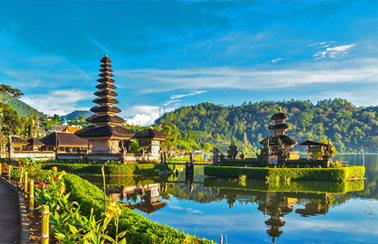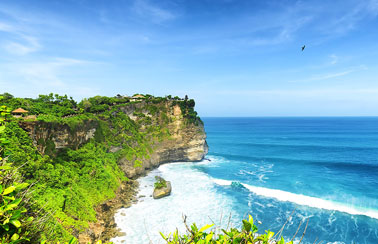Kertha Gosa Hall of Justice in Bali
Kertha Gosa is known locally as ‘Taman Gili Kertha Gosa’, is an historical landmark in Semarapura, the main town of the Klungkung regency in East Bali. Kertha Gosa forms part of the Puri Semarapura royal palace complex and features two main structures – a grand hall or the namesake Bale Kertha Gosa with ceilings filled with Kamasan or wayang-style paintings, and the Bale Kambang ‘floating' hall or pavillion that's surrounded by a moat.
The Kertha Gosa complex dates back to 1686 when it was commissioned by Dewa Agung Jambe, then ruler of the Klungkung kingdom. Kertha Gosa has undergone a series of restorations in the past (the latest was in 2014) and is one of Bali’s most important historical sites. Even though it is a national heritage site, Kertha Gosa is open for the public, and is a convenient stopover along Bali tour pacakage itineraries to Bali’s easthtern region.

Taman Gili Kertha Gosa features spacious and open halls inside a walled compound. Unique and traditional Balinese architecture can be seen throughout the gates, walls and main structures, and the main distinctive highlight of Kertha Gosa are the painted ceilings in the halls.
These paintings feature a technique often described as Kamasan style. Kamasan itself is a village in Klungkung that has become renowned for its typical style of paintings of wayang or traditional Balinese shadow puppetry figures. Kamasan paintings generally take inspiration from notable Hindu epics such as the Ramayana or the Mahabharata. Kamasan style can also be found in temples.
The paintings that adorn the ceilings of the Kertha Gosa halls were made on textile, yet a series of restoration projects carried out in 1930 had the pieces repainted onto plasterboards. The paintings depict spiritual teachings and guidance. When studied in detail, each of the pieces tells a different tale, one section may be of karma and reincarnation, and others of each phase of the human life from birth to death and the path to Nirvana.
The Bale Kambang ‘floating pavillion' that's surrounded by a moat. The paintings on its ceilings depict the tales from an old Javanese Sutasoma epic, with Prince Sutasoma as its protagonist.
Both sides of the bridges towards this ‘floating hall’ are adorned by guardian statues that depict characters from the epic and all surround a moat filled with lotuses. The hall structures served as a main place for the royal family to conduct important rituals and rites of passage. It also served as a court during the Dutch occupancy in Klungkung from 1908 to 1942.
In front of Kertha Gosa complex, exactly across the street, it was stand a stately monument made by black stone in form of Lingga Yoniwith a high of 28 meters and built on 123 meter square land. It is a Puputan Klungkung Monument and inaugurated on 28 April 1992. This monument is a memorial of an historical event on 28 April 1908 where in this monument was Puputan or all out war of the people under the leadership of Klungkung King against the Dutch soldiers. The war is begun because of Klungkung King forbidden to worship at the temple. This is an evident of persistent resistant against Dutch colonial effort to dig its claw into imperialism in Bali. The Klungkung people love freedom, great respect and uphold the majesty and holiness of those who had fallen in battle bloody cause of bullets from Dutch. In the memorial room is equipped with a diorama which depicts the struggle of Klungkung people with their king.
Kertha Gosa Location and Entrance Fee
Kertha Gosa located in Klungkung regency downtown. About 40 km from Denpasar city or 1 hour drive by car, to the east by crossing the by-pass Prof. Dr. Ida Bagus Mantra. The location is right in front of the Regent office of Klungkung regency. Kertha Gosa is open to the public with entry costing IDR 12,000 for domestic tourists and for foreigners.
-
Address: Jl. Kenanga No.11, Semarapura Kelod, Klungkung Regency, Bali , Indonesia



